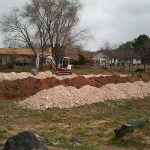 Would you like to learn how to avoid costly septic field repairs? Then continue reading.
Would you like to learn how to avoid costly septic field repairs? Then continue reading.
The leading cause of septic field failure
In speaking to different companies related to my septic system which was being inspected and pumped out, I learned about why septic systems fail and the new technology that can address one specific issue and save a significant amount of money and be better for the environment.
You must have your septic tank pumped every 2 to 3 years as recommended by Westchester County and it must be filed by the contractor pumping out your septic.
In simple terms, a septic system is made up of a septic tank for solids and leach fields for the wastewater. The solids are pumped out and the wastewater goes through several filters including the land around the leach fields recycling the sewage back into the environment. Unless a tank breaks or the leach fields are impacted by external factors (tree roots, excavating, etc) the system will continue to work.
The one factor that is of a natural occurrence that is the leading cause of the leach fields to fail is the build-up of biomat. Biomat is an anaerobic (does not require high levels of oxygen) bacteria layer which forms in the soil around the leach fields where the wastewater is discharged. Depending on how this the biomat forms, usually below the leach fields first, wastewater can rise to the surface. Over time the biomat can encircle the leach field causing water to drain slowly from the home and eventually causing the wastewater to back up into the home.
You can extend the life of your leach fields by:
- Pumping the septic tank more often reducing solids from getting into the leach fields and slowing the biomat build-up
- Using less water (fix leaking fixtures)
- Making sure water softeners are not backwashing too frequently
- Limiting the use of toxic cleaning products getting into the drains
Click here: Video on why septic systems fail
If a leach field is clogged, the typical approach is to abandon the field and add a new one if the property has space. That may be the most cost-effective approach initially, but eventually, over time, a costly repair project would be required to remove and recreate the leach fields.
Science-Based Solution
Jerry Fife used his experience and understanding of biology and the relationship of living organisms to develop a method that utilizes the most efficient bacteria to recycle human waste. This required adding oxygen to the septic system to grow different bacteria that would:
- Kill the bacteria of the solids in the septic tank
- The wastewater entering the fields would be cleansed of the food for the Biomat bacteria
- The biomat bacteria film in the leach fields would die due to lack of food, restoring the leach fields
This product is called the Pirana has been approved by the Massachusetts Department of Environment Protection under Title 5 Regulations as an innovative alternative septic-system technology. The product has a commercial and retail version. The commercial version is installed by certified installers and the retail version can be DIY by the homeowner:
- Commercial: Pirana
- Retail / DIY: Septic Genie (Approximately $1,500)
These products use the same technology, just with different distribution channels.
For a fraction of the cost, you can install either of these systems to greatly enhance the performance of your septic system to cleanse your solids and wastewater, protecting the environment and improving the longevity of your system.

